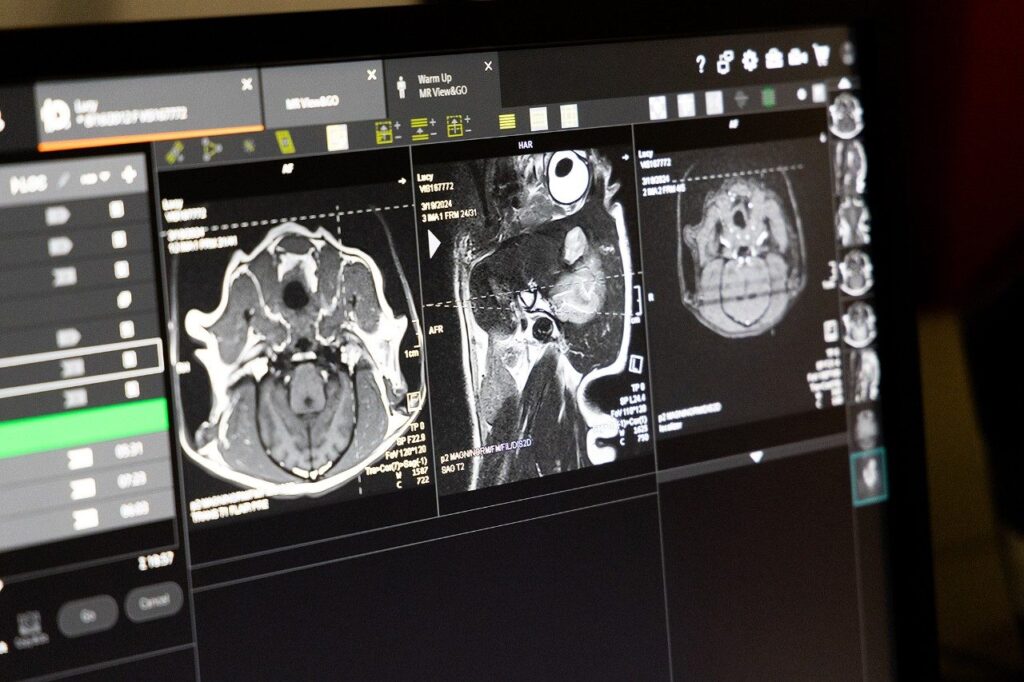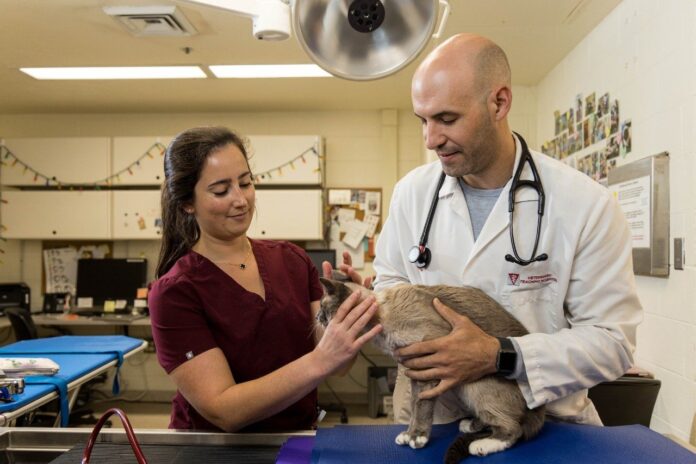A dog with a complex brain tumor has hope. A cat with severe spinal trauma can have a future. Each case is also an opportunity for breakthrough treatments pioneered by one of the most advanced veterinary neurology teams in the eastern United States at the Veterinary Teaching Hospital at Virginia Tech, where cutting-edge research meets compassionate care every day.
Led by John Rossmeisl, an internationally renowned veterinary neurosurgical pioneer researching and conducting next-generation brain surgery with translational potential to human medicine, the neurology service at the teaching hospital has four tenure-track faculty who combine their research and clinical prowess to serve clients who bring in their beloved pets from multiple states.
Only weekend service in Virginia
The Veterinary Teaching Hospital at Virginia Tech offers the only emergency neurology and neurosurgery service available seven days a week in Virginia with at least one of its four faculty members on rotation each weekend. The neurology team has taken patients from several surrounding states but is always looking for new cases.
The neurology team at the Virginia-Maryland College of Veterinary Medicine includes Rossmeisl and Assistant Professors Rell Parker, Richard Shinn, and Go Togawa; Doctor of Veterinary Medicine residents Christina Vezza, Leanne Jankelunas, and Myriam Martin; licensed veterinary technicians Flori Bliss, Brooke Hendricks, and Maureen Sroufe; and patient coordinator Melanie Dobbins.
The neurology team’s mission is threefold: research, clinical service, and education of the next generation of veterinary professionals. These purposes weave together seamlessly for the neurology team.
“The operating room is our living laboratory,” said Rossmeisl, the Dr. and Mrs. Dorsey Taylor Mahin Professor of Neurology and Neurosurgery.
Innovative research and techniques
Much of Rossmeisl’s research and clinical practice focuses on making brain surgery more effective but less invasive. This includes histotripsy, using focused sound waves to treat brain tumors; irreversible electroporation, or soft tissue ablation utilizing brief high-voltage electrical pulses to create nanopores in cell membranes; and various techniques for more targeted delivery of drugs, limiting side effects.
When Susan Ketcham noticed seizures in her 12-year-old dog, Lucy, she knew something was seriously wrong. Her search for help led her to Rossmeisl and Parker and a clinical trial in histotripsy.
“Being in human medicine myself, I work in operating rooms and am familiar with focused ultrasound,” said Ketcham, a clinical nurse specialist.
After the histotripsy treatment, surgeons carefully remove the treated tumor. This tissue provides crucial insights into the technique’s effect on cancer cells, helping researchers refine the technology for future applications.
“Lucy was quickly back to her playful self,” Ketcham said. “The recovery was quick, the incision was small. Knowing she’s helped advance science and technology is amazing.”

Transforming neurology
Rossmeisl arrived at Virginia Tech in 1998 as a resident in small animal internal medicine, becoming a clinical instructor in neurology and neurosurgery three years later. By 2003 he was an assistant professor and rose up the ranks to professor by 2016, associate department head in 2017, and served a stint as interim director of the Animal Cancer Care and Research Center in 2021-22.
“It’s been a long journey over these 25 years,” said Rossmeisl. “When I took the job back when Peter Eyre was the dean, the expectation was to transform the veterinary neurology service here, which was a relatively small, medically oriented service, and grow it and build the program while also developing neurosurgical expertise so we could treat all aspects of neurologic disease and in all species.”
Shinn came in 2016 as a resident in neurology and neurosurgery, becoming an assistant professor in 2020. He is adept in treating seizures and spinal injuries, constructing models with a 3D printer to assist in surgery, and, like Rossmeisl, seeking minimally invasive procedures.
“My research is very clinically based,” Shinn said. “And when it comes to what am I interested in with research, it’s common diseases, things like seizures or disc disease. We see them every day, but I feel we could do better. We can learn more. That’s where my focus is.”
Shinn said he was torn between entering private practice and academia, but “I much prefer academia for being able to teach, do research, and do clinics as well, whereas in private practice, you’re mostly just doing clinics.”
By Kevin Myatt

